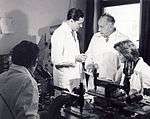Horia Hulubei
| Horia Hulubei | |
|---|---|
 | |
| Born |
November 15, 1896 Iaşi, Romania |
| Died |
November 22, 1972 (aged 76) Bucharest, Romania |
| Nationality | Romanian |
| Doctoral advisor | Jean Perrin |
| Known for | Development of X-ray spectroscopy |
| Notable awards | member of the Romanian Academy |
Horia Hulubei (Romanian pronunciation: [ˈhori.a huluˈbej]; November 15, 1896 – November 22, 1972) was a Romanian atomic/nuclear physicist, known for his contributions to the development of X-ray spectroscopy.
Education
He studied at the University of Iaşi and in Paris at the Sorbonne, with the Nobel laureate Jean Perrin as his PhD advisor; he obtained his Ph.D. from the Paris-Sorbonne University for his work with Jean Perrin.[1] His Ph.D. thesis with the title "Contribution to the study of quantum diffusion of X-rays" was defended in 1933 in Paris in front of an examination committee chaired by Nobel laureate Marie Curie.
Scientific achievements
With the help of his advanced X-ray spectroscopy equipment he observed several previously unidentified X-ray spectral lines, and subsequently came to the decision that such lines are associated with new elements. Then, he claimed and published the discovery of a new element "moldavium" in 1936, the discovery of "sequanium" in 1939 and that of "dor" in 1945. Later, however, it was shown that the reported X-ray lines did not belong to new elements.[2]
For his many scientific achievements the National Institute for Physics and Nuclear Engineering in Romania was named after him -- Horia Hulubei National Institute of Physics and Nuclear Engineering - IFIN HH. He was the Founder and First Director of the Institute of Atomic Physics (IFA) in Bucharest, Romania. He became a titular member of the Romanian Academy in 1946;[3] stripped of membership by the new communist regime in 1948, he was restored to the Academy in 1955.[4]
University teaching
During the early 1960s and 1970s he was also a Professor of Atomic Physics in the Department of Atomic and Nuclear Physics of the School of Physics at the University of Bucharest, where he delivered elegant and clear lectures on the Compton effect and inelastic Compton scattering/resonant inelastic X-ray scattering (RIXS).
Publications
- Course Notes of Physical Chemistry, Ed. Academiei, Bucharest, 1940. ( "Curs de chimie fizică "(1940))
- X-ray Spectroscopy ("Spectroscopia X"). (1948)
- The Structure of Matter. "Structura materiei" (1950)
Publications at the Library of Congress
References
- ↑ Constantinescu, Bogdan; Bugoi, Roxana (1998). "Romanian University Physics Teaching and Research (1860–1940)". Science & Education. 7 (3): 307. Bibcode:1998Sc&Ed...7..307C. doi:10.1023/A:1008657521233.
- ↑ Fontani, Marco (2005-09-10). "The Twilight of the Naturally-Occurring Elements: Moldavium (Ml), Sequanium (Sq) and Dor (Do)". International Conference on the History of Chemistry. Lisbon. pp. 1–8. Archived from the original on 2006-02-24. Retrieved 2007-04-08.
- ↑ (Romanian) Membrii Academiei Române din 1866 până în prezent at the Romanian Academy site
- ↑ Dan Berindei, "Academia Română și revoluția din decembrie 1989", in Memoriile Secției de Științe Istorice, Volume 33/2008, p. 157